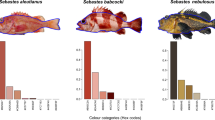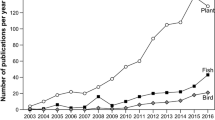Summary
‘Decisions’ made as to what prey types to include in the diet were analysed for two populations of the spider,Agelenopsis aperta existing under markedly different prey availability and predation levels. Potential prey types were ranked as to their relative profitabilities with respect to energy gain per handling effort and predation risk. Members of the population experiencing limited prey availability but low risk of predation to visually hunting predators exhibited a significantly higher capture attempt rate towards all prey encountered than the population for which prey were abundant but for which predation was a significant problem. Neither spider population preferentially attacked prey that exhibited higher profitability rankings. An experiment was completed that indicates thatA. aperta can discriminate between more and less profitable prey. Suggestions are made as to why the population experiencing abundant food did not exhibit a narrower diet when compared to the population existing under limited food.
Similar content being viewed by others
References
Caraco, T. (1980) On foraging time allocation in a stochastic environment.Ecology 61, 119–28.
Caraco, T. and Chasin, M. (1984) Foraging preferences: response to reward skew.Anim. Behav. 32, 76–85.
Caraco, T. and Gillespie, R. G. (1986) Risk-sensitivity: foraging mode in an ambush predator.Ecology 67, 1180–5.
Greenstone, M. H. (1978) Spider feeding behavior optimises dietary essential amino acid composition.Nature 282, 501–3.
Griffiths, D. (1980) The feeding biology of ant lion larvae: prey capture, handling and utilization.J. Anim. Ecol. 49, 99–125.
Hammerstein, P. and Riechert, S. E. (1988) Payoffs and strategies in territorial contests: ESS analyses of two ecotypes of the spiderAgelenopsis aperta.Evol. Ecol. 2, 115–38.
Hedrick, A. V. and Riechert, S. E. (1989) Population variation in the foraging of a spider: the role of genetics.Ecologia 80, 533–9.
Heinrich, B. and Heinrich, J. E. (1984) The pit-trapping foraging strategy of the ant lion,Myrmeleon immaculata (Neuroptera: Myrmeleontidae).Behav. Ecol. Sociobiol. 14, 151–60.
Krebs, J. R. and Davies, N. B. (1981)An Introduction to Behavioural Ecology. Sinauer, Sunderland, USA.
Pimentel, R. A. (1979)Morphometrics, pp. 276. Kendall Hunt, Dubuque, Iowa, USA.
Pyke, G. H. (1984) Optimal foraging theory: A critical review.Ann. Rev. Ecol. Syst. 15, 523–75.
Pyke, G. H., Pulliam, H. R. and Charnov, E. L. (1977) Optimal foraging: a selective review of theory and tests.Quart. Rev. Biol. 52, 137–54.
Riechert, S. E. (1976) Web-site selection in a desert spider,Agelenopsis aperta (Gertsch).Oikos 27, 311–5.
Riechert, S. E. (1978) Energy-based territoriality in populations of the desert spider,Agelenopsis aperta (Gertsch).Symp. Zool. Soc. London 42, 211–22.
Riechert, S. E. (1979) Games spiders play II: resource assessment strategies.Behav. Ecol. Sociobiol. 4, 1–8.
Riechert, S. E. (1981) The consequences of being terroritial: spiders, a case study.Amer. Natur. 117, 871–92.
Riechert, S. E. (1986) Spider flights: a test of evolutionary game theory.Amer. Sci. 4, 604–10.
Riechert, S. E. and Tracy, C. R. (1975) Thermal balance and prey availability: bases for a model relating web-site characteristics to spider reproductive success.Ecology 56, 265–84.
Riechert, S. E. and Luczak, J. (1982) Spider foraging: behavioral repsonses to prey. InBiology of Spider Communication: Mechanisms and Ecological Signicance (P. N. Witt and J. Rovner, eds). Princeton University Press, Princeton, USA.
Riechert, S. E. and Hedrick, A. V. (1990) Levels of predation and genetically based anti-predatory behavior in the spider,Agelenopsis aperta.Anim. Behav. 40, 679–88.
Rogers, L. E., Hinds, W. T. and Buschbom, R. L. (1976) A general weight vs length relationship for insects.Ann. Entomol. Soc. 69, 387–9.
Sokal, R. R. and Rohlf, F. J. (1981)Biometry. W. H. Freeman, San Francisco, USA.
Stephens, D. W. and Charnov, E. L. (1982) Optimal foraging: some simple stochastic models.Behav. Ecol. Sociobiol. 10, 251–63.
Stephens, D. W. and Krebs, J. R. (1986)Foraging Theory. Princeton University Press, Princeton, USA.
Townsend, C. R. and Hughes, R. N. (1981) Maximizing net energy returns from foraging. InPhysiological ecology: an evolutionary approach to resource use. (C. R. Townsend and P. Calow, eds). Sinauer Press, Sunderland, USA.
Waddington, K. D. and Holden, L. R. (1979) Optimal foraging: on flower selection by bees.Amer. Natur. 114, 179–96.
Wilson, D. S. (1974) Prey capture and competition in the ant-lion.Biotropica 6, 187–93.
Author information
Authors and Affiliations
Rights and permissions
About this article
Cite this article
Riechert, S.E. Prey abundance vs diet breadth in a spider test system. Evol Ecol 5, 327–338 (1991). https://doi.org/10.1007/BF02214236
Issue Date:
DOI: https://doi.org/10.1007/BF02214236




